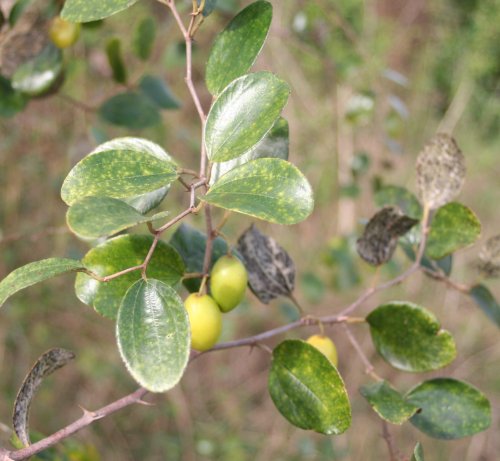Common Name: Indian jujube
Family: Rhamnaceae
Common Synonyms: none
USDA Hardiness Zone: NA
Growth Habit: Tree
Origin: Southern Asia, Eastern Africa
FISC Category: -
FDACS Listed Noxious Weed: NA
Introduction Date: Earliest Florida specimen vouchered in 1973
IFAS Assessment:

This deciduous small tree or large shrub is densely branched with zigzag branches. Branches typically have a leaf and a thorn at each angle. Leaves are ovoid, glossy green above and nearly white underneath. Over time, the leaves typically become infested with a fungus, causing the leaves to have a yellow-mottled appearance above and turn black below. Flowers are small and inconspicuous, greenish-white, and emit an unpleasant odor. The fruits are edible, and are similar in shape and size to the native hog plum (Ximenia americana). The fruits are initially green, but have a yellow to pale orange color when ripe. Seeds are enclosed within a woody endocarp.
NA
Species is a prolific seed producer, individuals over 3m tall can produce over 5,000 fruits (Grice 1998). Seeds are dispersed by feral swine and birds in Australia, which is the likely means of dispersal in Florida. Currently known from Miami-Dade, Lee, Collier and Glades counties.

NA
IFAS Publication SSAGR307. Biology and Control of Indian Jujube (Ziziphus mauritiana): A Weed to Watch in Florida Pastures and Natural Areas. http://edis.ifas.ufl.edu/pdffiles/AG/AG31300.pdf
Global Invasive Species Database. Ziziphus mauritiana: http://www.iucngisd.org/gisd/species.php?sc=214
Grice, A. C. 1998. Ecology in the management of Indian jujube (Ziziphus mauritiana). Weed Science 46:467-474.
Pacific Island Ecosystemes at Risk (PIER). http://www.hear.org/pier/species/ziziphus_mauritiana.htm